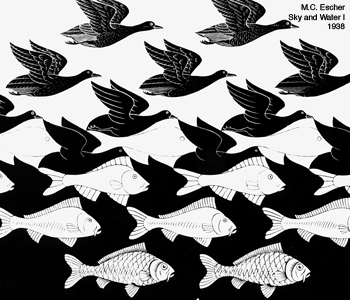Feature
Broadband Nonlinear Frequency Conversion
Researchers are working to develop new techniques for nonlinear frequency conversion as well as new crystal design structures to help meet this need. Their work is leading to applications in optical communications, metrology and other areas.
 M.C. Escher, Sky and Water I (1938). Escher's famous woodcut drawing helps to illustrate the concept of adiabatic (slow-varying) evolution, which can play a significant role in optical processes such as frequency conversion.
M.C. Escher, Sky and Water I (1938). Escher's famous woodcut drawing helps to illustrate the concept of adiabatic (slow-varying) evolution, which can play a significant role in optical processes such as frequency conversion.
Most of the optical phenomena that we encounter in everyday life—such as refraction, absorption and dispersion—occur in the realm of linear optics. With these types of linear optical effects, the intensity or propagation direction of the light wave can change based on the interaction between light and matter. However, other properties of light—in particular, the spectrum of colors contained in the beam—remain completely unaffected.
…Log in or become a member to view the full text of this article.
This article may be available for purchase via the search at Optica Publishing Group.
Optica Members get the full text of Optics & Photonics News, plus a variety of other member benefits.
